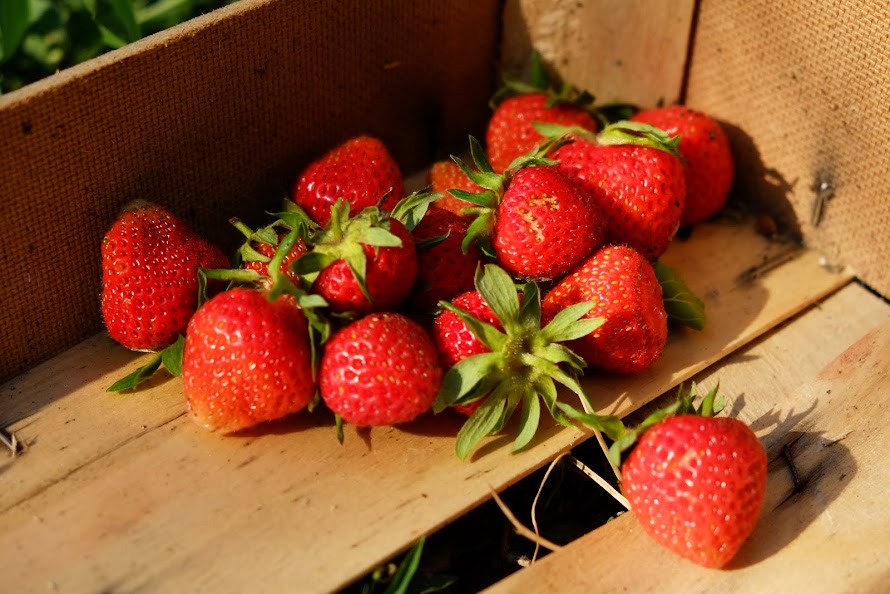 |
| The VMV Supermarket chain advertising their great selection of fresh Bulgarian fruits and vegetables |
Having my family in Finland and Bulgaria means that I visit
these two countries every summer. This time around I noticed new aspects about
Bulgarian cuisine and eating style that may not be so clearly visible for those
that don’t know any locals or the language.
Firstly, I was happy to see that many grocery store chains have
started using the freshness of their produce as a marketing trick – Lidl (a
German chain) even boasts that they are the only store to employ a freshness
manager to make sure they carry the freshest fruits and vegetables possible. I
would love to see something like this in the U.S.!
 |
| A different take on Caprese salad with cucumber puree - delicious! |
On a more worrying note, I noticed that people in Bulgaria use
a lot of salt. To begin with, food products, especially cheese, tend to echo
this trend by being very salty. Salt is also often heavily added to finished dishes
both at home and in a restaurant – often without first tasting them. I personally
had no need to add salt to any of my meals and on the other hand, when I cooked
something, it wasn’t salty enough to others. The problem is that people are so
used to eating high amounts of salt that upon trying to reduce it, the food
doesn’t taste as good, which makes improvement difficult. Also, as learned
during my spring semester at Berkeley, high salt intake tends to increase the
craving for salt forming a classic vicious cycle.
 |
| Self-picked |
Observing this high salt intake, I wanted to find out
whether it has an effect on Bulgarian national health. Not surprisingly, when
it comes to deaths due to hypertension (in which salt is a factor), Bulgaria
had the third highest rate in Europe in 2011(1). Even though Bulgarians have
also healthy eating habits, such as having salad as an appetizer at lunch and
dinner, this doesn’t seem to be enough to counteract the effects of salt. Of
course, salt is always added to salad, too. Tomato and cucumber are by far the
most popular vegetables and in my opinion, Bulgarians could benefit from adding
variety to their raw vegetable intake. However, I’ve seen many people eat very
few vegetables and not just in Bulgaria, so having the same or almost the same
vegetables every day is better than having no veggies at all.
 |
| Grandma's cherries |
Interestingly, however, most people that have a yard grow their own
produce and not just tomatoes and cucumbers: thus, there is a great potential
for increasing variety. My husband’s grandmother, for example, grows also strawberries,
lettuce, carrots, beans, plums, cherries and corn among others. For pensioners,
growing some vegetables doesn’t only provide fresh food, but it also is a good
way to reduce food costs as pensions are very small. Some even produce honey for
sale to add to their meager monthly incomes. Unfortunately, pesticides are
widely used even on these backyard gardens, as according to many gardeners,
there wouldn’t be much produce left for consumption without them. I didn’t find
out what is used, but I hope that there is not much residue left when it is
time to do harvest.
 |
| Cauliflower bake |
During this year’s trip, I noticed also that foraging is pretty
common here, most popular items being plants that can be dried for tea or other
ways used for making different kinds of drinks and syrups. Mashterka, for
instance, is a tiny purple flower, which turns into a delicious herbal tea! I
had the opportunity to pick some, as we came across it on one of our trips to see
ancient ruins. By the way, there are plenty of archeological attractions to see
here – this country has roots that go deep!
I hope you have enjoyed my post. See you next time!
Anna-Kaisa
Sources:
(1) Hypertension.
World Health Rankings 2011 http://www.worldlifeexpectancy.com/cause-of-death/hypertension/by-country/
20 June 2015
